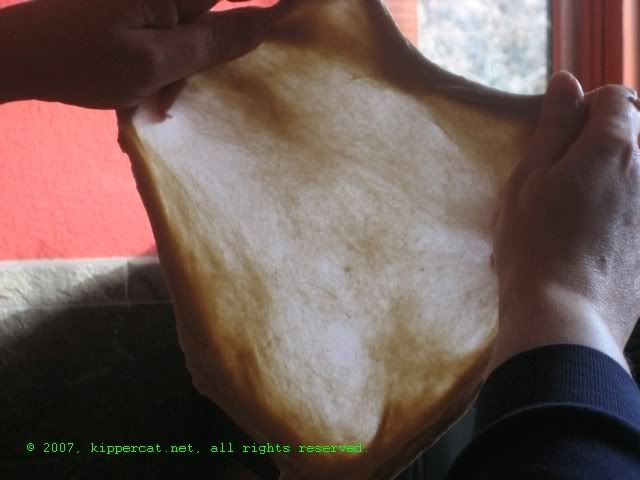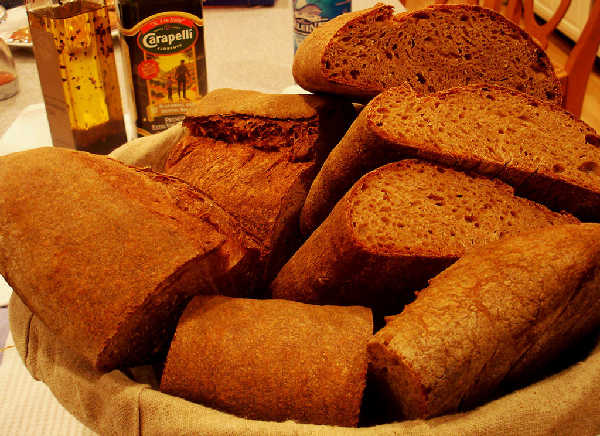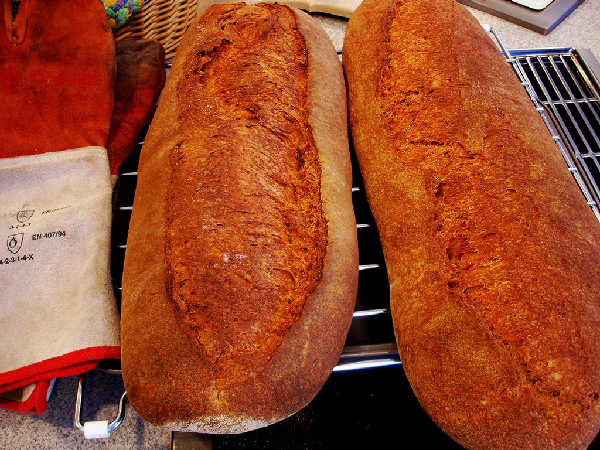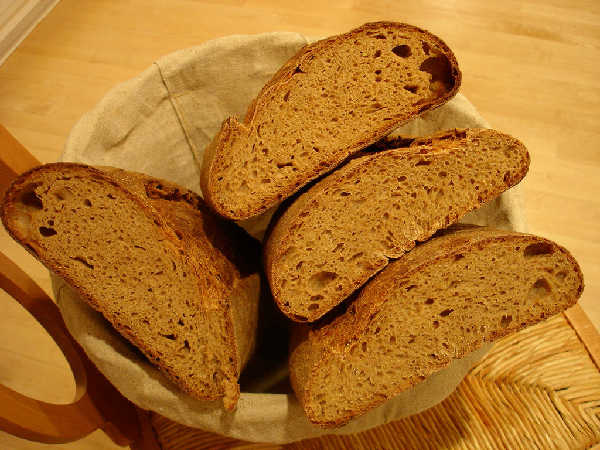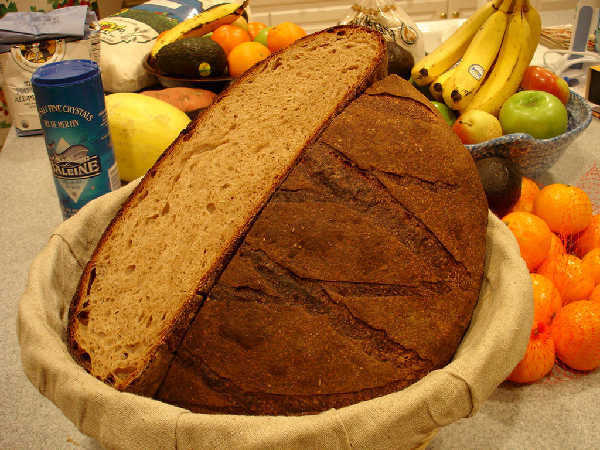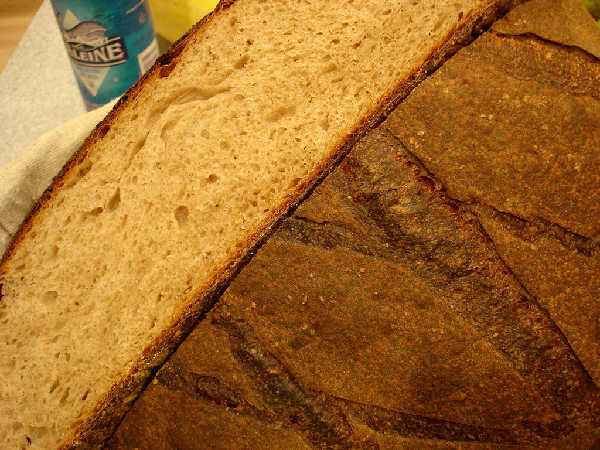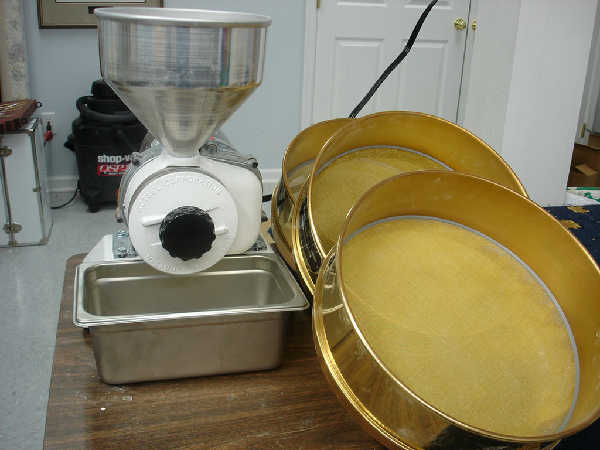
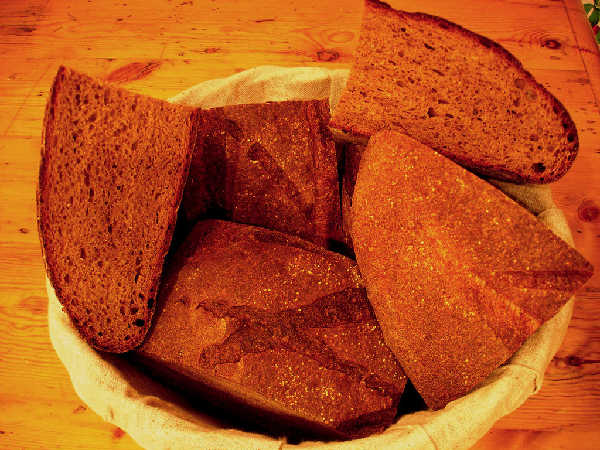
JMonkey's many blog entries on whole wheat, as well several other TFLer's posts, helped me learn to make whole grain breads that are light and flavorful, rather than the rocks and bricks I had thought were inevitable with whole wheat. Then, Peter Reinhart's Whole Grain Breads came out, and I learned more about the reasons for soakers and mashes and gave mash bread a try. Then, I read some posts by Ron, who has posted passionately about whole grains and pushed me to think about trying home milling. Finally, Goetter mentioned stone milling at home with his Retsel, which he said was easy to clean and use, and I was off and running. I just recently received my Retsel Mil-Rite, and I'm happy to say it works just great - quite fast (5 pounds/hr for reasonably finely milled flour) and easy to clean if you need a few pounds of freshly milled whole grain flour.
However, unlike many or most of the home milling aficionados, I am as interested in traditional methods and recipes as I am in the nutritional aspects of bread. As such, I do want to be able to create "high extraction flour" or maybe even some regular bread flour from my whole grain berries to satisfy interests in country style miches and other types of bread that may call for other than pure whole wheat flour. In order to accomplish that, the flour needs to be sifted. MiniOven mentioned brass sieves, and some internet searches revealed a number of places. I finally purchased a range of brass sieves from number 18 through 120 from http://www.lmine.com, hoping to experiment with them to extract more refined flours from my freshly milled whole grain flour. While conversing with the people at Legend Mine, they said it would be backbreaking to sift very much flour by hand, and that I should consider a "sieve shaker". I don't have the sieve shaker yet, but it will arrive soon.
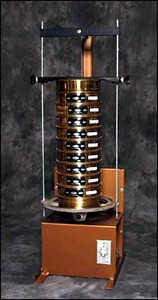
Meanwhile, I went through a laborious process of discovering the right coarseness of grind and which sieves to use. I found that I could get very reasonable results by setting the mill stone adjustment to be just slightly looser than finger tight. The flour coming out was fairly fine - good for a whole wheat bread flour. Yet, it had some percentage of larger particles. I then successively sifted the flour through my #20, #40, and #60 sieves. The #20 caught large particles of bran, about 5% of the weight. The #40 sieve caught smaller particles of bran and other dark parts of the kernel - probably some of the germ from the look of it, with a weight of about 15%. The #60 sieve was catching what I would call a very dark flour, probably some combination of bran, germ, and outer endosperm, about another 15% of the weight. What came out of the bottom of the #60 sieve was very nice bread flour, creamy and slightly dark colored. I'm sure that flour from # 60 would have made a delicious whitish bread. So, the sifting is nowhere near where it could be with a shaker and will never be anything close to the perfect filtering done by commercial mills. However, for my purposes, even this very spur-of-the-moment hand processing was enough to get 65% fresh, creamy, bread flour.
As for grain, I ordered 25 lbs. of Wheat MT Prairie Gold, 25 lbs. of Wheat MT Bronze Chief, 10 lbs. of their wheat berries (hard red winter wheat berries, I think), and 5 lbs. each of spelt and rye berries. I stored them in 6 gallon buckets with screw on hermetically sealed lids and placed oxygen absorbers in the buckets. A 6 gallon bucket comfortably holds 25 lbs. of grain with enough room for the screw-on lid. All the storage buckets and lids were purchased form http://www.pleasanthillgrain.com.
Although the Retsel appears to be more than adequate in retrospect, I went off the deep end ealier in the week and ordered a Meadows 8 inch mill also. This one will grind much faster and hopefully won't be too hard to clean.
To create my high extraction flour, I just took the finest 85% that came out of my sifting, which amounted to all of the bread flour (throughs from the #60), all of the throughs from the #40 (a darker semolina-like flour), and some of the throughs from the #20 sieve (very dark, very coarse), such that I had 85% of the total weight of all the flour that I sifted. I then ran the coarser flours back through the mill at a fairly fine setting, which resulted in making those coarse components much more finely milled. I mixed them in with the good bread flour coming out of the #60 sieve, and that is what I used as my "high extraction flour".
I also finely milled enough spelt and rye to make 55g of whole rye flour and 105g of whole spelt flour. I just mixed all the rye and spelt berries together and ran them through the mill once.
I then made my high extraction miche, along the lines of a Thom Leonard Country French with a spelt and rye levain. The overall recipe is 15% fermented flour in a spelt and rye levain, mixed with a soaker of the high extraction flour with 1% malt syrup, 2% flour, and 1 tbsp of diastatic barley powder.
Some photos of the process are posted. Spreadsheets are posted in xls and html format.
Levain:
- 30g firm storage starter (any starter will work - use 25% more batter starter or about 50% more liquid starter)
- 52g whole rye flour
- 104g whole spelt flour
I mixed this starter at 12:45AM after a night of much experimentation and exercise manually sifting about 10 cups of grain into 40 samples from the sieves trying to figure out the best settings for the mill. The levain was designed to rise by double and ferment an hour or so more by 9:00 AM.
Soaker:
- 10g diastatic malt powder
- 15g malt syrup
- 30g salt
- 1024g water
- 1300g home milled and manually sifted high extraction flour
I mixed the soaker in a large bowl using a scraper until it was reasonably well mixed. The mixing was done at about 1:00AM and the soaker was refrigerated overnight.
Dough:
At 9:00AM in the morning, the soaker was spread out on a wet counter like a great big pizza. The levain was chopped into marshmallow-sized pieces which spread evenly over the soaker and pressed into the dough with the palms of my wet hands. The dough was rolled up and folded a few times, squished all through with wet hands a few times, rolled a couple of times, and placed in my DLX mixer. The dough was mixed/kneaded in the DLX mixer on low to medium for 4 minutes, allowed to rest for 4 minutes, and then mixed for 4 more minutes.
Bulk Fermentation and Folding
The dough was allowed to rise at a temperature of approximately 74F in a cabinet above my coffee machine. Initially the temperature was around 70, but by the end of the bulk fermentation the temperature was up to about 76F. During the bulk fermentation, I folded the dough at 10:40AM, 11:40AM, and 12:40AM. The total bulk fermentation time was 5.25 hours at roughly 74F.
Shaping and Proofing
One large boule was formed at 2:15PM, allowed to sit for 15 minutes on the counter, and turned upside down into one of those San Francisco Baking Institute lined baskets (12" diameter). I dusted the loaf and the basket liner with some of the bran and semolina-like flour from my siftings mixed with a small amount of rice flour. In retrospect, since the dough was not that hydrated (77%), it wasn't necessary to use the rice flour. I could have just used some of my home sifted bran and nothing else.
The basket was placed in a large ZipLoc "Big Bag" with a warm bowl of water and sealed. The proofing temperature was about 75F. I slashed with cross-hatch pattern and baked at 5PM for a total mix to bake time of 8 hours, and a proofing time, starting from 2:15PM of 2:45.
Bake
The loaf was baked in my brick oven. The oven was fired earlier and allowed to cool to a hearth temperature of about 450F. I sprayed the loaves with an orchid mister, sprayed the chamber of the oven until it was full of steam (20 seconds), and sealed the door with my wooden wet towel covered door. The bread was rotated every 15 minutes for a total of about 50 minutes bake time. The oven door was left open after 20 minutes, and the hearth temperature dropped to about 400F at the end of the bake.
To do this in a kitchen oven, heat oven to 450F, create steam however you do it, and then drop the oven temperature to about 400F. If the loaf becomes too dark, cover with foil and/or drop the temperature to 350F. Allow to thoroughly bake, so the color of the crust is uniformly dark but hopefully not burnt and the internal temperature is above 205F.
Cool
Allow to completely cool before cutting - several hours at least.
Results
The miche has a color that is darker than my usual whole wheat loaves, which may be partly because my sifting wasn't that efficient, partly because the extraction rate may be higher than for Golden Buffalo, which I would normally use for this application, and maybe just the nature of freshly milled flour, which I've never tried before. The texture is definitely lighter and softer than I expect from a whole grain, so the high extraction worked in that sense. The flavor is closer to a whole grain loaf than I expected. If I want a more mild white flour flavor, it may mean using less of the darker, larger particles, i.e. use a slightly lower extraction rate. By the way, the aroma of the fresh flour when mixed with water is most definitely better than anything I've smelled using commercial flour. Everyone in the house commented on the great aroma coming from the dough and the bread. I do believe the flavor and aroma of the bread is enhanced by the freshness of the milling, something commented on by many on the site.
The Next Phase
When I receive my Meadows mill and the sieve shaker, the next phase of the project will be to discover the right settings of the mills and sieves to gain a more efficient separation of the particles from the milling.
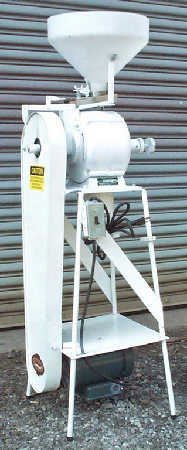
But Why Did I Do This?
OK, part of it is just fun with gadgets. However, there are several objectives beyond that. One very significant motivation is that I haven't been very happy with the availability of other than white flour or whole wheat flour. I'd like to be able to create flours with various characteristics in the amount I need when I need it. Also, any flour other than white flour will probably have spoilage issues if kept for too long. So, rather than buy a few pounds of some specific flour, pay a lot for shipping, and then use a small amount and throw out the rest when it spoils, I can create the desired flours to order. Much of the bran can be used for dusting or added to cereal, and even the middlings may be tossed into oatmeal or toasted and used in place of wheat germ, as suggested in the Essential's Columbia recipe. If I can make the process convenient and fast, then it will be easier and cheaper in the long run to occasionally buy bulk amounts of a few different berries, as I already just did. Storage is easy for the berries, and they stay fresh for a very long time in berry form.
The result is a drastic improvement in the freshness of my flours, very little waste or spoilage, and much lower cost. I seem to spend upwards of $4/pound including shipping for small quantities to get particular flours I want over the internet. The berries, purchased mostly in 25 lb. quantities, came to less than $2/pound, even if I'm very particular and buy from Wheat MT or Heartland Mill. It could be much less if I can find sources for high quality berries locally. However, it's not a bad guess to say I lose close to half my purchased whole grain flours to spoilage. I could offset the spoilage with flour freezing strategies, but I just think this home milling approach is better. No freezing, easy to use screw-on lids on buckets of grain, and absolutely fresh flour to order. At least, that's what I'm shooting for.
It's true that the cost of the mill and sifting equipment won't be offset by the lower cost of the berries for something like 2-3 years. However, for me the home milling approach is still justified because of the freshness, flexibility of flours I can generate, and the convenience of storing berries. The fact the lower cost will allow for the recover of the cost of the equipment even if it takes a few years is just an added benefit.
Of course, the benefits above are theoretical. Maybe after the next phase, I'll conclude it's not possible to produce the desired flour characteristics with simple sieves and a small stone mill. However, the first phase was almost sufficient, other than the excessive physical effort required to manually sift the flour. If I can make the separation work a little better by discovering the right series of millings and siftings, which should be far easier to do with the sieve shaker, I'm hopeful the results will justify doing it regularly going forward.

